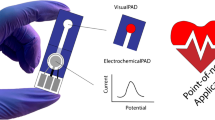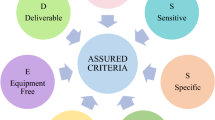Abstract
A disposable visual microfluidic immunosensor is described for the determination of foodborne pathogens using immunomagnetic separation, enzymatic catalysis and distance indication. Specifically, a sensor was designed to detect Salmonella typhimurium as a model pathogen. Magnetic nanoparticles (MNPs) were modified with the anti-Salmonella monoclonal antibodies and then used to enrich S. typhimurium from the sample. This is followed by conjugation to polystyrene microspheres modified with anti-Salmonella polyclonal antibodies and catalase to form the MNP-bacteria-polystyrene-catalase sandwich. The catalase on the complexes catalyzes the decomposition of hydrogen peroxide to produce oxygen after passing a micromixer. The generated oxygen gas increases the pressure in the chip and pushes the indicating red dye solution to travel along the channel towards the unsealed outlet. The travel distance of the red dye can be visually read and related to the amount of S. typhimurium using the calibration scale. The sensor can detect as low as 150 CFU·mL−1 within 2 h.

Schematic representation of the distance-based microfluidic immunosensor for visual detection of foodborne bacteria using immunomagnetic nanoparticles for bacteria separation, catalase for decomposition of hydrogen peroxide to form oxygen which causes a pressure increase, and red dyed particles movement for distance indication.





Similar content being viewed by others
References
Rubab M, Shahbaz HM, Olaimat AN, Oh D-H (2018) Biosensors for rapid and sensitive detection of Staphylococcus aureus in food. Biosens Bioelectron 105:49–57
WHO, Food safety, http://www.who.int/en/news-room/fact-sheets/detail/food-safety, 2017
Zhao X, Lin CW, Wang J, Oh DH (2014) Advances in rapid detection methods for foodborne pathogens. J Microbiol Biotechnol 24(3):297–312
Mandal PK, Biswas AK, Choi K, Pal UK (2011) Methods for rapid detection of foodborne pathogens: an overview. Am J Food Technol 6(2):87–102
Wang M, Yang J, Gai Z, Huo S, Zhu J, Li J, Wang R, Xing S, Shi G, Shi F, Zhang L (2017) Comparison between digital PCR and real-time PCR in detection of Salmonella typhimurium in milk. Int J Food Microbiol 266:251–256
Mao Y, Huang X, Xiong S, Xu H, Aguilar ZP, Xiong Y (2016) Large-volume immunomagnetic separation combined with multiplex PCR assay for simultaneous detection of Listeria monocytogenes and Listeria ivanovii in lettuce. Food Control 59:601–608
Kim J, Kim H, Park JH, Jon S (2017) Gold Nanorod-based photo-PCR system for one-step, rapid detection of Bacteria. Nanotheranostics 1(2):178–185
Bennett RW (2005) Staphylococcal enterotoxin and its rapid identification in foods by enzyme-linked immunosorbent assay-based methodology. J Food Prot 68(6):1264
Tu Z, Chen Q, Li Y, Xiong Y, Xu Y, Hu N, Tao Y (2016) Identification and characterization of species-specific nanobodies for the detection of Listeria monocytogenes in milk. Anal Biochem 493:1–7
Ahmed A, Rushworth JV, Hirst NA, Millner PA (2014) Biosensors for whole-cell bacterial detection. Clin Microbiol Rev 27(3):631–646
Magiati M, Sevastou A, Kalogianni DPJMA (2018) A fluorometric lateral flow assay for visual detection of nucleic acids using a digital camera readout. Microchim Acta 185(6):314
Yoo SM, Lee SY (2016) Optical biosensors for the detection of pathogenic microorganisms. Trends Biotechnol 34(1):7–25
Ramon-Marquez T, Medina-Castillo AL, Fernandez-Gutierrez A, Fernandez-Sanchez JF (2016) A novel optical biosensor for direct and selective determination of serotonin in serum by solid surface-room temperature phosphorescence. Biosens Bioelectron 82:217–223
Pastucha M, Farka Z, Lacina K, Mikusova Z, Skladal P (2019) Magnetic nanoparticles for smart electrochemical immunoassays: a review on recent developments. Mikrochim Acta 186(5):312
Nabaei V, Chandrawati R, Heidari H (2018) Magnetic biosensors: Modelling and simulation. Biosens Bioelectron 103:69–86
Rong Z, Wang C, Wang J, Wang D, Xiao R, Wang S (2016) Magnetic immunoassay for cancer biomarker detection based on surface-enhanced resonance Raman scattering from coupled plasmonic nanostructures. Biosens Bioelectron 84:15
Yuan M, Zhang Q, Song Z, Ye T, Yu J, Cao H, Xu F (2019) Piezoelectric arsenite aptasensor based on the use of a self-assembled mercaptoethylamine monolayer and gold nanoparticles. Microchim Acta 186(5):268
Pohanka M (2018) Piezoelectric biosensor for the determination of tumor necrosis factor alpha. Talanta 178:970–973
Chen Y, Chu W, Liu W, Guo X (2018) Distance-based carcinoembryonic antigen assay on microfluidic paper immunodevice. Sensors Actuators B Chem 260:452–459
Tian T, Li J, Song Y, Zhou L, Zhu Z, Yang CJ (2016) Distance-based microfluidic quantitative detection methods for point-of-care testing. Lab Chip 16(7):1139–1151
Wang Y, Zhu G, Qi W, Li Y, Song Y (2016) A versatile quantitation platform based on platinum nanoparticles incorporated volumetric bar-chart chip for highly sensitive assays. Biosens Bioelectron 85:777–784
Xie Y, Wei X, Yang Q, Guan Z, Liu D, Liu X, Zhou L, Zhu Z, Lin Z, Yang C (2016) A Shake&Read distance-based microfluidic chip as a portable quantitative readout device for highly sensitive point-of-care testing. Chem Commun 52(91):13377–13380
Liu D, Li X, Zhou J, Liu S, Tian T, Song Y, Zhu Z, Zhou L, Ji T, Yang C (2017) A fully integrated distance readout ELISA-Chip for point-of-care testing with sample-in-answer-out capability. Biosens Bioelectron 96:332–338
Ansari MA, Kim K-Y, Anwar K, Kim SM (2010) A novel passive micromixer based on unbalanced splits and collisions of fluid streams. J Micromech Microeng 20(5):055007
Chen Y, Xianyu Y, Wu J, Dong M, Zheng W, Sun J, Jiang X (2017) Double-enzymes-mediated bioluminescent sensor for quantitative and ultrasensitive point-of-care testing. Anal Chem 89(10):5422–5427
Li J, Xia G, Li Y (2013) Numerical and experimental analyses of planar asymmetric split-and-recombine micromixer with dislocation sub-channels. J Chem Technol Biotechnol 88(9):1757–1765
Dong J, Zhao H, Xu M, Ma Q, Ai S (2013) A label-free electrochemical impedance immunosensor based on AuNPs/PAMAM-MWCNT-chi nanocomposite modified glassy carbon electrode for detection of Salmonella typhimurium in milk. Food Chem 141(3):1980–1986
Liu K, Yan X, Mao B, Wang S, Deng L (2015) Aptamer-based detection of Salmonella enteritidis using double signal amplification by Klenow fragment and dual fluorescence. Microchim Acta 183(2):643–649
Lei P, Tang H, Ding S, Ding X, Zhu D, Shen B, Cheng Q, Yan Y (2014) Determination of the invA gene of Salmonella using surface plasmon resonance along with streptavidin aptamer amplification. Microchim Acta 182(1–2):289–296
Juronen D, Kuusk A, Kivirand K, Rinken A, Rinken T (2018) Immunosensing system for rapid multiplex detection of mastitis-causing pathogens in milk. Talanta 178:949–954
Cheng Y, Xianyu Y, Wang Y, Zhang X, Cha R, Sun J, Jiang X (2015) One-step detection of pathogens and viruses: combining magnetic relaxation switching and magnetic separation. ACS Nano 9(3):3184–3191
Liu CC, Yeung CY, Chen PH, Yeh MK, Hou SY (2013) Salmonella detection using 16S ribosomal DNA/RNA probe-gold nanoparticles and lateral flow immunoassay. Food Chem 141(3):2526–2532
Acknowledgments
This study was supported in part National Natural Science Foundation of China (31802219) and Walmart Foundation (SA17031161). The authors would like to thank Walmart Food Safety Collaboration Center for its great support.
Author information
Authors and Affiliations
Corresponding author
Ethics declarations
Conflict of interest
The authors declare that they have no conflict of interest.
Additional information
Publisher’s note
Springer Nature remains neutral with regard to jurisdictional claims in published maps and institutional affiliations.
Electronic supplementary material
ESM 1
(DOCX 5711 kb)
Rights and permissions
About this article
Cite this article
Cai, G., Zheng, L., Liao, M. et al. A microfluidic immunosensor for visual detection of foodborne bacteria using immunomagnetic separation, enzymatic catalysis and distance indication. Microchim Acta 186, 757 (2019). https://doi.org/10.1007/s00604-019-3883-x
Received:
Accepted:
Published:
DOI: https://doi.org/10.1007/s00604-019-3883-x




